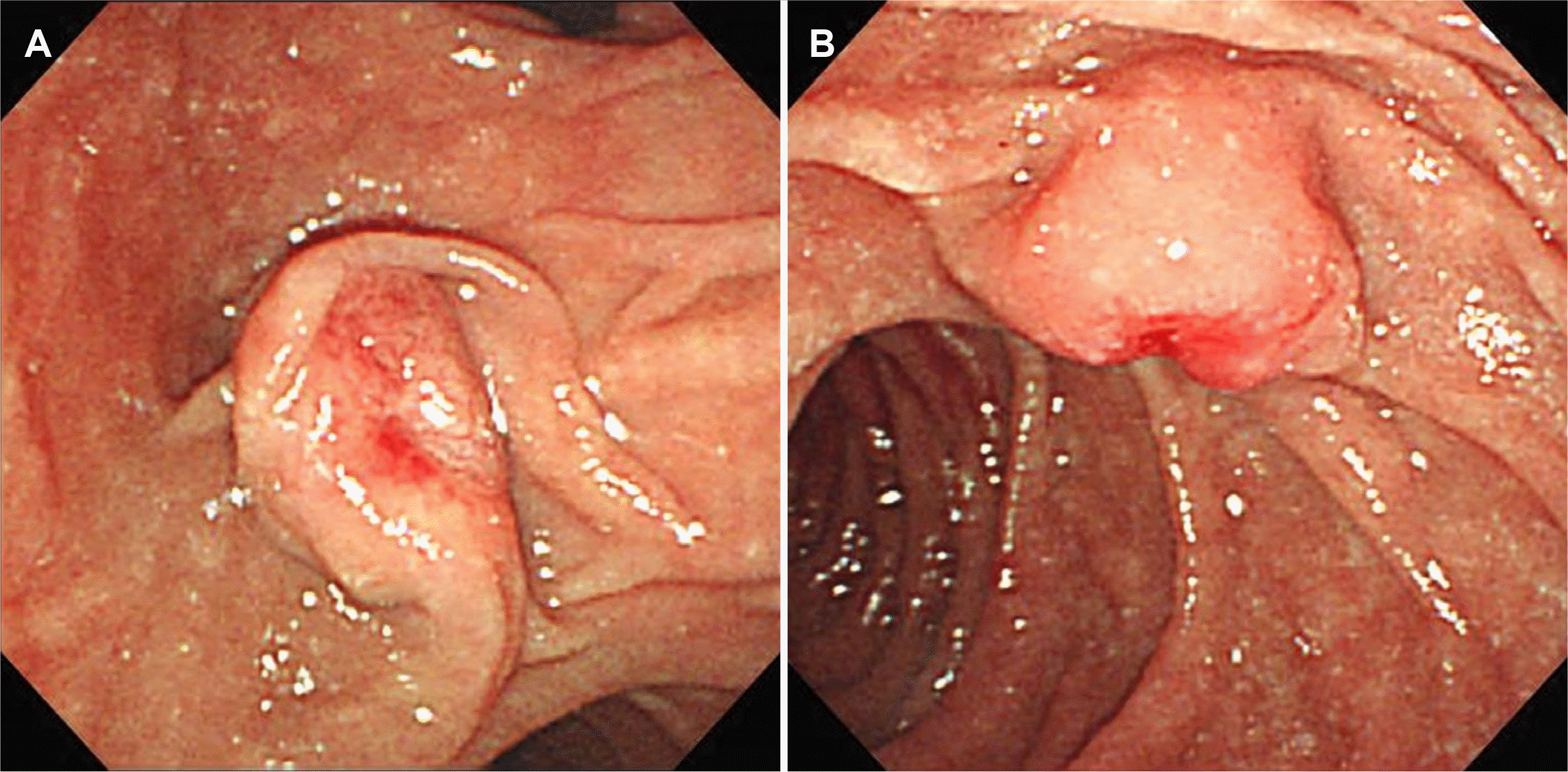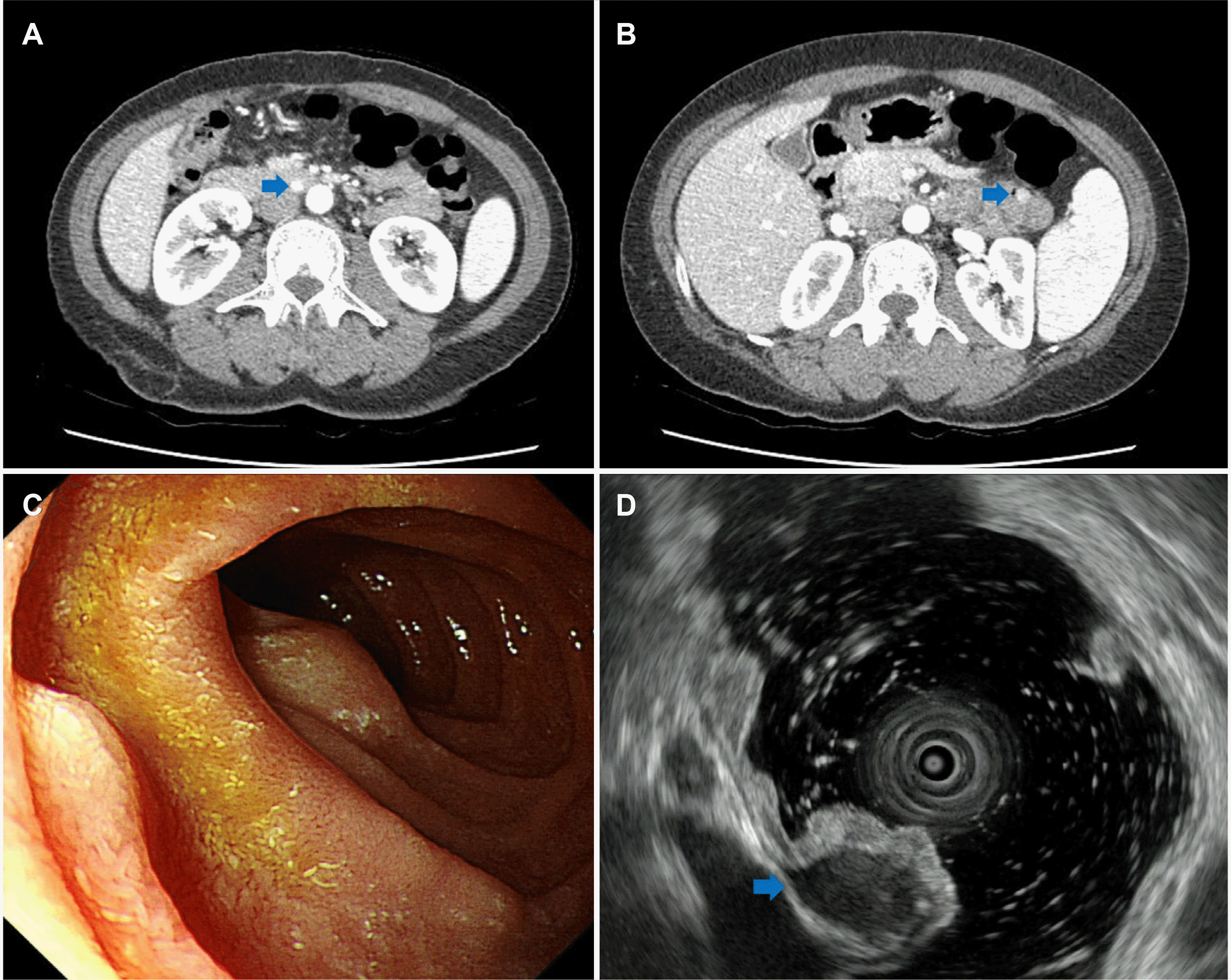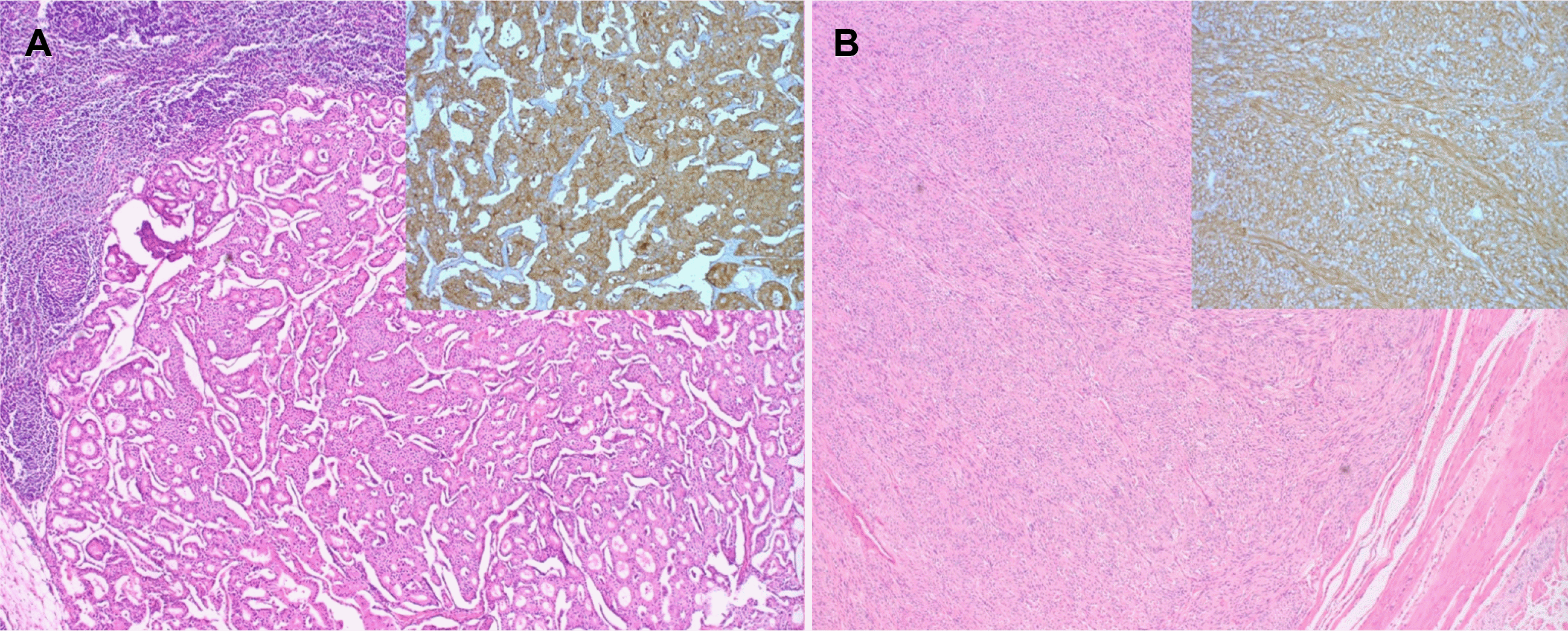1. Taal BG, Visser O. 2004; Epidemiology of neuroendocrine tumours. Neuroendocrinology. 80(Suppl 1):3–7. DOI:
10.1159/000080731. PMID:
15477707.

2. Miettinen M, Lasota J. 2001; Gastrointestinal stromal tumors--definition, clinical, histological, immunohistochemical, and molecular genetic features and differential diagnosis. Virchows Arch. 438:1–12. DOI:
10.1007/s004280000338. PMID:
11213830.

3. Miettinen M, Sarlomo-Rikala M, Lasota J. 1999; Gastrointestinal stromal tumors: recent advances in understanding of their biology. Hum Pathol. 30:1213–1220. DOI:
10.1016/S0046-8177(99)90040-0. PMID:
10534170.

4. Raphael MJ, Chan DL, Law C, Singh S. 2017; Principles of diagnosis and management of neuroendocrine tumours. CMAJ. 189:E398–E404. DOI:
10.1503/cmaj.160771. PMID:
28385820. PMCID:
PMC5359105.

5. El-Menyar A, Mekkodathil A, Al-Thani H. 2017; Diagnosis and management of gastrointestinal stromal tumors: an up-to-date literature review. J Cancer Res Ther. 13:889–900. DOI:
10.4103/0973-1482.177499. PMID:
29237949.
6. Seo YK, Choi JS. 2018; Endoscopic papillectomy for synchronous major and minor duodenal papilla neuroendocrine tumors. Korean J Gastroenterol. 72:217–221. DOI:
10.4166/kjg.2018.72.4.217. PMID:
30419648.

8. Wiedenmann B, Franke WW, Kuhn C, Moll R, Gould VE. 1986; Synaptophysin: a marker protein for neuroendocrine cells and neoplasms. Proc Natl Acad Sci U S A. 83:3500–3504. DOI:
10.1073/pnas.83.10.3500. PMID:
3010302. PMCID:
PMC323544.

9. Nagtegaal ID, Odze RD, Klimstra D, et al. 2020; The 2019 WHO classification of tumours of the digestive system. Histopathology. 76:182–188. DOI:
10.1111/his.13975. PMID:
31433515. PMCID:
PMC7003895.

10. Stueven AK, Kayser A, Wetz C, et al. 2019; Somatostatin analogues in the treatment of neuroendocrine tumors: past, present and future. Int J Mol Sci. 20:3049. DOI:
10.3390/ijms20123049. PMID:
31234481. PMCID:
PMC6627451.

12. Raymond E, Dahan L, Raoul JL, et al. 2011; Sunitinib malate for the treatment of pancreatic neuroendocrine tumors. N Engl J Med. 364:501–513. DOI:
10.1056/NEJMoa1003825. PMID:
21306237.

13. Hirota S, Isozaki K, Moriyama Y, et al. 1998; Gain-of-function mutations of c-kit in human gastrointestinal stromal tumors. Science. 279:577–580. DOI:
10.1126/science.279.5350.577. PMID:
9438854.

14. Heinrich MC, Corless CL, Duensing A, et al. 2003; PDGFRA activating mutations in gastrointestinal stromal tumors. Science. 299:708–710. DOI:
10.1126/science.1079666. PMID:
12522257.

15. Postow MA, Robson ME. 2012; Inherited gastrointestinal stromal tumor syndromes: mutations, clinical features, and therapeutic implications. Clin Sarcoma Res. 2:16. DOI:
10.1186/2045-3329-2-16. PMID:
23036227. PMCID:
PMC3496697.

17. Gasparotto D, Rossi S, Bearzi I, et al. 2008; Multiple primary sporadic gastrointestinal stromal tumors in the adult: an underestimated entity. Clin Cancer Res. 14:5715–5721. DOI:
10.1158/1078-0432.CCR-08-0622. PMID:
18779314.

18. Demetri GD, van Oosterom AT, Garrett CR, et al. 2006; Efficacy and safety of sunitinib in patients with advanced gastrointestinal stromal tumour after failure of imatinib: a randomised controlled trial. Lancet. 368:1329–1338. DOI:
10.1016/S0140-6736(06)69446-4. PMID:
17046465.

19. Raut CP, Posner M, Desai J, et al. 2006; Surgical management of advanced gastrointestinal stromal tumors after treatment with targeted systemic therapy using kinase inhibitors. J Clin Oncol. 24:2325–2331. DOI:
10.1200/JCO.2005.05.3439. PMID:
16710031.

20. Sym SJ, Ryu MH, Lee JL, et al. 2008; Surgical intervention following imatinib treatment in patients with advanced gastrointestinal stromal tumors (GISTs). J Surg Oncol. 98:27–33. DOI:
10.1002/jso.21065. PMID:
18452195.

21. Park SJ, Ryu MH, Ryoo BY, et al. 2014; The role of surgical resection following imatinib treatment in patients with recurrent or metastatic gastrointestinal stromal tumors: results of propensity score analyses. Ann Surg Oncol. 21:4211–4217. DOI:
10.1245/s10434-014-3866-4. PMID:
24980089.

22. Blay JY, Bonvalot S, Casali P, et al. 2005; Consensus meeting for the management of gastrointestinal stromal tumors. Report of the GIST Consensus Conference of 20-21 March 2004, under the auspices of ESMO. Ann Oncol. 16:566–578. DOI:
10.1093/annonc/mdi127. PMID:
15781488.

23. Tavares AB, Viveiros FA, Cidade CN, Maciel J. 2012; Gastric GIST with synchronous neuroendocrine tumour of the pancreas in a patient without neurofibromatosis type 1. BMJ Case Rep. 2012:bcr0220125895. DOI:
10.1136/bcr.02.2012.5895. PMID:
22675144. PMCID:
PMC4543145.

24. Poredska K, Kunovsky L, Prochazka V, et al. 2019; Triple malignancy (NET, GIST and pheochromocytoma) as a first manifestation of neurofibromatosis type-1 in an adult patient. Diagn Pathol. 14:77. DOI:
10.1186/s13000-019-0848-7. PMID:
31301733. PMCID:
PMC6626625.

25. Lin YL, Wei CK, Chiang JK, Chou AL, Chen CW, Tseng CE. 2008; Concomitant gastric carcinoid and gastrointestinal stromal tumors: a case report. World J Gastroenterol. 14:6100–6103. DOI:
10.3748/wjg.14.6100. PMID:
18932294. PMCID:
PMC2760185.

26. Hung CY, Chen MJ, Shih SC, et al. 2008; Gastric carcinoid tumor in a patient with a past history of gastrointestinal stromal tumor of the stomach. World J Gastroenterol. 14:6884–6887. DOI:
10.3748/wjg.14.6884. PMID:
19058321. PMCID:
PMC2773889.

27. Samaras VD, Foukas PG, Triantafyllou K, et al. 2011; Synchronous well differentiated neuroendocrine tumour and gastrointestinal stromal tumour of the stomach: a case report. BMC Gastroenterol. 11:27. DOI:
10.1186/1471-230X-11-27. PMID:
21435225. PMCID:
PMC3070680.

28. Wu E, Son SY, Gariwala V, O'Neill C. 2021; Gastric gastrointestinal stromal tumor (GIST) with co-occurrence of pancreatic neuroendocrine tumor. Radiol Case Rep. 16:1391–1394. DOI:
10.1016/j.radcr.2021.03.014. PMID:
33912253. PMCID:
PMC8063710.








 PDF
PDF Citation
Citation Print
Print



 XML Download
XML Download